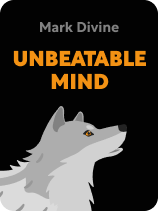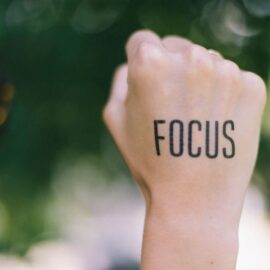

This article is an excerpt from the Shortform book guide to "Unbeatable Mind" by Mark Divine. Shortform has the world's best summaries and analyses of books you should be reading.
Like this article? Sign up for a free trial here.
Want to know how to build self-awareness? Why is understanding the human brain important for developing awareness?
In Unbeatable Mind, Mark Divine writes that developing the mental strength of an unbeatable mind means mastering five levels of personal development. According to him, learning how to build self-awareness is a crucial step in this process.
Read on to learn Divine’s advice for building self-awareness to identify and follow your purpose in life.
Building Self-Awareness
According to Mark Divine’s system in Unbeatable Mind, which features five levels of personal development along with tips for how to traverse these levels, to enact meaningful change within yourself and be able to navigate the five levels of development, you must learn to be constantly aware of what’s going on inside you and around you. This involves understanding how your brain functions and learning how to build self-awareness to best control it.
(Shortform note: You can also use knowledge about how the brain functions to enhance your learning, as research shows that understanding how the brain learns and adopting a growth mindset improves learning outcomes in children.)
Animal Brains
To build self-awareness, you’ll start by learning how to understand your mind, and that includes your physical brain and its different functions. Divine explains that the human brain evolved over millennia, building up from lower levels of functioning and ability to more complex functioning. As it progressed through these stages of evolution, it built upon itself, and many of the neurological traits that formed in our brain’s earliest stages of development have stayed with us rather than being bred out of us.
The three stages of our brain’s evolution are:
1) Reptile: The first of our three “brains” to develop was the reptile brain. It consists of the cerebellum and the brain stem and is responsible for maintaining our basic bodily functions such as heartbeat and motor control.
2) Mammalian: The second brain to develop was the mammalian brain, which is responsible for higher functions like emotions, as well as our reactions to stressors.
3) Monkey: The final brain to develop was the monkey brain, or neocortex. This is responsible for higher-level thinking and learning like analysis, creativity, planning, and decision-making. This brain is ripe with the potential to create and innovate, but it’s also pleasure-seeking and unwilling to tolerate pain. Since pleasure is not always productive and pain is necessary for growth, you must work hard to train this brain.
(Shortform note: The concept of the three animal brains evolving and maintaining their original structure and functions in discrete parts has been widely accepted for decades, but recent research has debunked this idea. It indicates that the human brain did not evolve directly from the reptile brain and that it cannot be separated into distinct regions that function independently of each other. Instead, the brain functions as a highly interconnected web of neural networks that touch on and incorporate all parts of the brain for many different functions.)
According to Divine, these different brains need to be under the control of the mind, which involves learning how to build self-awareness. He emphasizes that the mind is separate from the brain’s neurological functions. He calls the mind the “witness,” meaning the conscious and purposeful awareness of your brain’s functions.
To achieve higher levels of consciousness, you must train your mind to have control over your neocortex. This training can be done through a number of eastern practices like yoga and meditation, and Divine has based his own system on these practices.
(Shortform note: Divine’s view of consciousness as separate from the functioning of the brain is generally not accepted by science. While it may seem like the mind is something greater than the sum of its physical parts, research shows that the processes of the mind and the memories and knowledge that inform those processes are stored physically in the brain, suggesting that the idea of a higher consciousness is an illusion.)
Divine says that in order for the mind to become the master of the neocortex, we have to embrace a state of silence in the mind. To do this, he advises that you push out all distractions, and he recommends various meditation techniques (which we review at the end of the guide).
When you embrace a state of silence, you can better connect with your higher self and the universe. This takes practice and feels unnatural at first, since western culture teaches us to constantly analyze everything. However, tapping into this silence and using it to identify negative thoughts and replace them with positive thoughts is the impetus for personal change.
(Shortform note: In The Art of Happiness, the Dalai Lama recommends a method for stilling the mind that involves taking on a neutral state of mind and pushing out distractions, like Divine’s method. He also emphasizes that you’re not just tuning out, but that you should stay alert and connect with your mind in a pure state.)
How to Use Your Awareness to Fulfill Your Purpose
Divine says that building self-awareness and putting your mind in charge of your neocortex teaches you how to identify and follow your purpose. To identify your purpose, ask yourself how you can pursue your passions, how you can embody the traits you feel are important to your character, and what you exist to do. Once you’ve answered these questions, you can focus on the steps you need to take to fulfill your purpose: building emotional strength, building mental strength, and establishing and following through on goals.
| The Purpose of Your Purpose Many authors have written about the importance of finding your purpose in life and using it to guide your actions and thoughts. For example, in The Success Principles, Jack Canfield echoes Divine’s sentiment that your purpose is essential to your success and happiness. To find your purpose, he recommends reflecting on what makes you happy, noticing your interests and skills, and envisioning what you want the world to be like. He also recommends meditation and a few questionnaires to help you pinpoint your goals. Likewise, in Flow, Mihaly Csikszentmihalyi agrees that your purpose is vital in achieving happiness, and he suggests that finding your purpose requires you to alternate your focus between yourself and your community. He also distinguishes between different kinds of purposes, including purposes that you take on willingly and feel internally motivated to pursue versus purposes that you follow because others expect you to do so. Similarly, in The Monk Who Sold His Ferrari, Robin Sharma adds to the idea that your purpose will guide you through life and says that your purpose should involve helping others in some way. If you struggle with Divine’s guidelines on how to find your purpose, the methods recommended by these and other authors may help you narrow it down. |
How to Train Your Mind
To navigate Divine’s five levels of development in Unbeatable Mind, learn how to build self-awareness, and apply that awareness to your own growth, you must train both your mind and body, says Divine. Divine shares a number of meditation and concentration techniques that he has learned or developed through studying such systems as Ashtanga yoga, Seido karate, and other eastern practices.
Practice these skills while keeping your mind focused on your purpose. This will give you the ability to turn your concentration on and off on command.
(Shortform note: In addition to helping with concentration and building self-awareness, meditation can also help with mental health issues such as anxiety and panic attacks, as it helps shift your focus from sadness about the past or fear of the future to calmness in the present moment.)
Mantra
To build self-awareness, Divine suggests coming up with a mantra for yourself. A mantra is a short phrase that provides a positive or motivational boost to your mind. According to Divine, choosing an effective, positive, and catchy mantra will allow you to redirect your negative thoughts and replace them with positive thoughts that align with your needs and goals. You’ll use this mantra regularly in your practices, and eventually it’ll blend into your mental backdrop so you no longer have to consciously employ it.
(Shortform note: A mantra is a type of positive affirmation. In addition to conveying a positive idea as Divine says, your mantra will work better if it uses positive words as well, such as saying “I am strong” rather than “I am not weak” so that your focus is on the word strong and the word “weak” doesn’t slip into your subconscious.)
A mantra is essential for personal development but can also be very useful in motivating teams. As a leader, if you see your team struggling with motivation or feeling defeated, introduce a mantra that will reinvigorate them and refocus their attention on the task at hand.
(Shortform note: Research shows that repeating a statement or idea again and again makes us more likely to believe it’s true, even with simple ideas that we should know are false. Repeating a positive mantra can be particularly effective in teams involving children, as you’re teaching them positive ideas about themselves that they’ll internalize as truths.)
| Meditation for Other Purposes Both of Divine’s meditation techniques are designed for concentrating on and analyzing what you believe, but there are many meditation practices available that focus on different results and activities. Mantra meditation is the practice of focusing on and repeating a mantra. This style helps you push out distractions, and the chanting of the mantra lets your breathing slip into a relaxing rhythm. Mantra meditation helps with focus, memory, energy, and mood. Spiritual meditation involves using self-reflection to connect with something higher or greater than the self. This can be a religious entity, but the practice isn’t specific to religion. It requires you to let go of negative feelings toward others and focus on helping them from a place of authenticity. Spiritual meditation can help with enriching your inner life, strengthening your faith, and seeking to help others. Present-moment meditation is a practice designed to center your awareness on the present, pushing out thoughts about the future or the past and tuning in to your senses—what you see, hear, and feel—in the moment. It can help with stress management and heart health, and it can also help you manage certain conditions like learning or mood disorders. Candle-gazing meditation involves focusing your eyes on an object—like the flame of a candle—in order to focus your mind on your own awareness. If you struggle to clear your mind in regular meditation, the visual stimulus of the candle can make it easier to clear out distracting thoughts. Candle-gazing meditation can help with sleep issues, concentration, and executive function, and may even improve eyesight. All of these practices can help you build the type of self-awareness Divine describes—in addition to their other benefits—and aid you in your personal development and the building of your unbeatable mind. |

———End of Preview———
Like what you just read? Read the rest of the world's best book summary and analysis of Mark Divine's "Unbeatable Mind" at Shortform.
Here's what you'll find in our full Unbeatable Mind summary:
- Advice from a former Navy SEAL on how to maximize your success
- Tools for training your mind and developing mental toughness
- Why you should come up with a mantra for yourself






